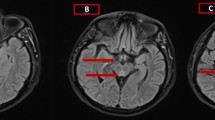Abstract.
Wernicke's encephalopathy is an uncommon disorder caused by a thiamine deficiency which is clinically characterized by the triad of ophthalmoplegia, ataxia and disturbances of consciousness, each finding being variably present. The disease is caused by malnutrition or malabsorption, and is often associated with prolonged alcohol intake, neoplasm and extensive inflammatory processes of the digestive tract and parenteral hyperalimentation-induced gastrointestinal mucosal atrophy. Clinical diagnosis can be elusive and MRI may be the only imaging technique able to detect the cerebral lesions, whose type and distribution are characteristic of the Wernicke's encephalopathy, whereas CT is positive only in exceptional cases. We report a case of a 56-year-old woman who developed a Wernicke's encephalopathy 1 month after a colonic resection with signal intensity changes located in the mammillary bodies and in the medial thalamic nuclei.
Similar content being viewed by others
Author information
Authors and Affiliations
Additional information
Received 7 March 1997; Revision received 28 August 1997; Accepted 14 November 1997
Rights and permissions
About this article
Cite this article
Pagnan, L., Berlot, G. & Pozzi-Mucelli, R. Magnetic resonance imaging in a case of Wernicke's encephalopathy. Eur Radiol 8, 977–980 (1998). https://doi.org/10.1007/s003300050499
Issue Date:
DOI: https://doi.org/10.1007/s003300050499




